Sporty and Simple is the ClubSwan 28
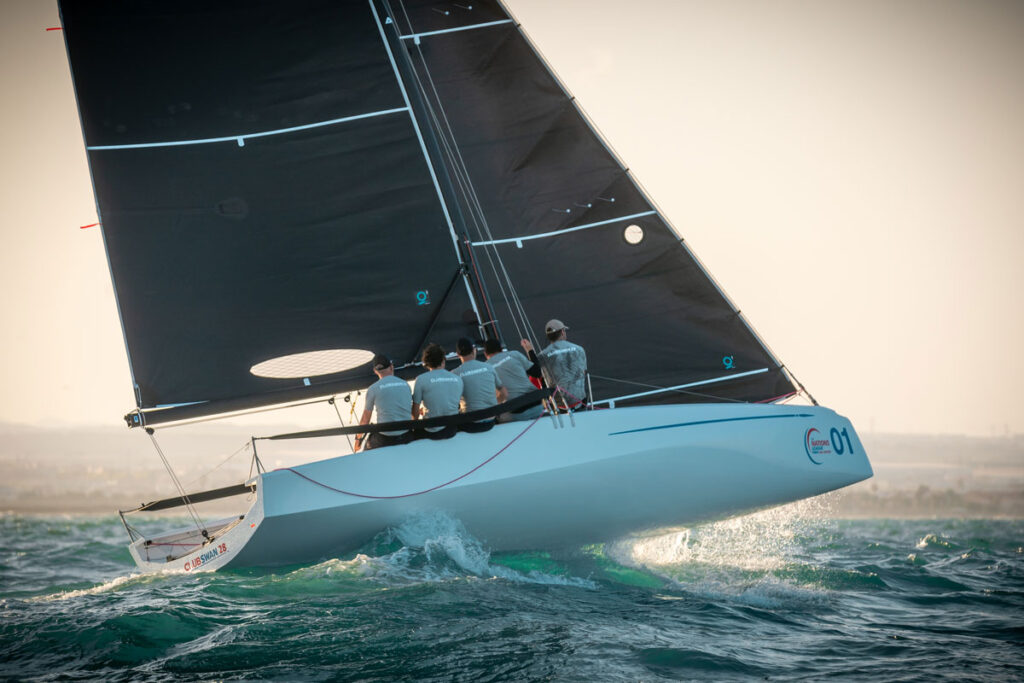 The ClubSwan 28 one-design starts at 200,000 euro. With an adjustable hydraulic mast jack, rig-tension tweaks can be made on the fly.
Nautor Communication
The ClubSwan 28 one-design starts at 200,000 euro. With an adjustable hydraulic mast jack, rig-tension tweaks can be made on the fly.
Nautor Communication
With its long history producing good-looking fast cruisers, in recent years, Nautor Swan has consolidated its performance yachts into its ClubSwan range, spanning the giant 125-foot Skorpios and the 80-footer My Song to their fleets of ClubSwan 36s and 50s. All designs by Juan Kouyoumdjian, the latter saw 11 and 15 compete in their respective five-event annual championships (Nations Cup) in 2023 and are set to be joined by the ClubSwan 43 this year. But Nautor Swan has another new development: While its smallest boats have been the ClubSwan 36 (plus the original Swan 36 back in 1967), its latest launch is its smallest ever, the ClubSwan 28.
This new model is not surprising given that Swan is sailing’s most prolific premium brand, with more large performance sailing yachts in existence than any other manufacturer. Its range firmly extends into the superyacht stratosphere, so why not lure new owners into the fold, earlier, with a modest offering? Federico Michetti, head of sports activities and product manager at Nautor Swan, explains, “The concept of the 28 is to have an entry-level Swan that allows owners to enjoy the journey with Nautor and our events.” He expects that the 28 will entice younger sailors, even those new to sailing, into the ClubSwan realm.
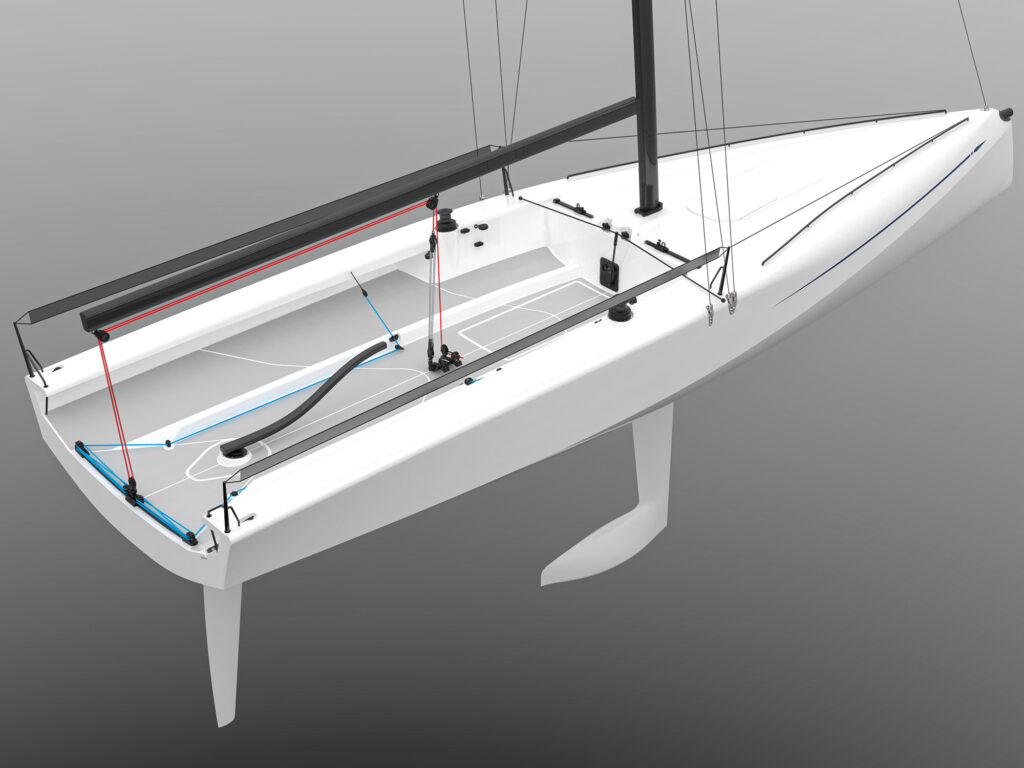 The ClubSwan 28 is the smallest model ever produced by Nautor Swan.
Nautor Swan
The ClubSwan 28 is the smallest model ever produced by Nautor Swan.
Nautor Swan
Among race boats today, 28 to 30 feet is the cusp between sportboat and yacht, and the ClubSwan 28 is more the former, given its light weight (displacing sub-1,200 kg versus 1,600 kg and 1,800 for the more yachtlike Farr 280 and Cape 31, respectively); outboard engine rather than inboard; and low freeboard and minimal interior, accessed via the foredeck hatch. The ClubSwan 28 is neither an excessively high-end carbon race boat nor a high-volume J/70, but rather somewhere between. “Our aim for it is to race well in 6 knots or 20. It is a powerful boat but not extreme,” Michetti says.
Kouyoumdjian adds: “We incorporated everything that modern boats have to perform very well but didn’t go extreme on any of them.”
Fundamental to the boat’s ethos is simplicity, and for it to be fun to sail, but as Michetti puts it, “at the same time being safe, a boat that can fit the needs of everyone from beginner to expert.”
Aside from its performance, the best demonstration of this is that while most sportboat crews must hike and hike hard (it being so vital to stability on boats of this size), the 28 is a “legs-in” boat.
“We would like to avoid a hiking contest. It is much more social too; sailors can enjoy what is happening around them,” Michetti says. Everything is optimized for this—the sheerline and cockpit arrangement to make maximum use of the weight of the inward-facing crew, while keel draft and ballast make up righting moment lost due to no hiking and crew not moving fore and aft.
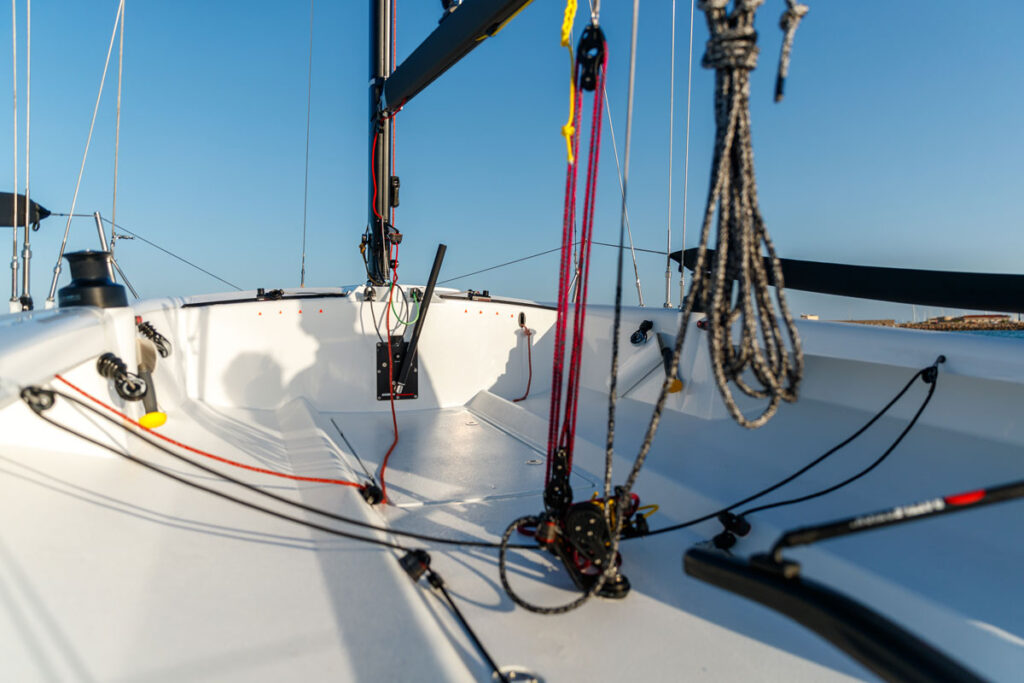 The ClubSwan 28’s cockpit and control systems are clean and simple.
Nautor Communication
The ClubSwan 28’s cockpit and control systems are clean and simple.
Nautor Communication
Compared with the ClubSwan 36’s advanced hull shape and fixed-keel/C-foil combination, the 28 is far more conservative. The hull has a low wetted surface area and rocker aft to minimize bow burying. Its modest 8-foot beam means it can be towed legally throughout Europe without having to be inclined. It also allows the boat and trailer combined to fit into a 40HQ container for shipping farther afield.
The hull shape is quite complex, with flared topsides at the stern, above a substantial chine. Going forward, the topsides turn vertical and then evolve into a deck chamfer forward of the mast. The bow has a slight reverse sheer and a retractable sprit.
The rig breaks new ground, but again, simplicity is the focus. Developed between Kouyoumdjian, Southern Spars’ Steve Wilson and mast-builder Axxon Composites, it is skifflike, with no backstay or runners, and with swept-back spreaders and a GNAV (inverted vang) to keep the cockpit clear. “Imagine a 49er rig that is set up by the headstay,” Kouyoumdjian says. “The prebend and the tension you have in that kind of rig usually comes from presetting the headstay and then you deal with it with the vang and cunningham. But we wanted something variable that could simulate what you could otherwise do with the runners.”
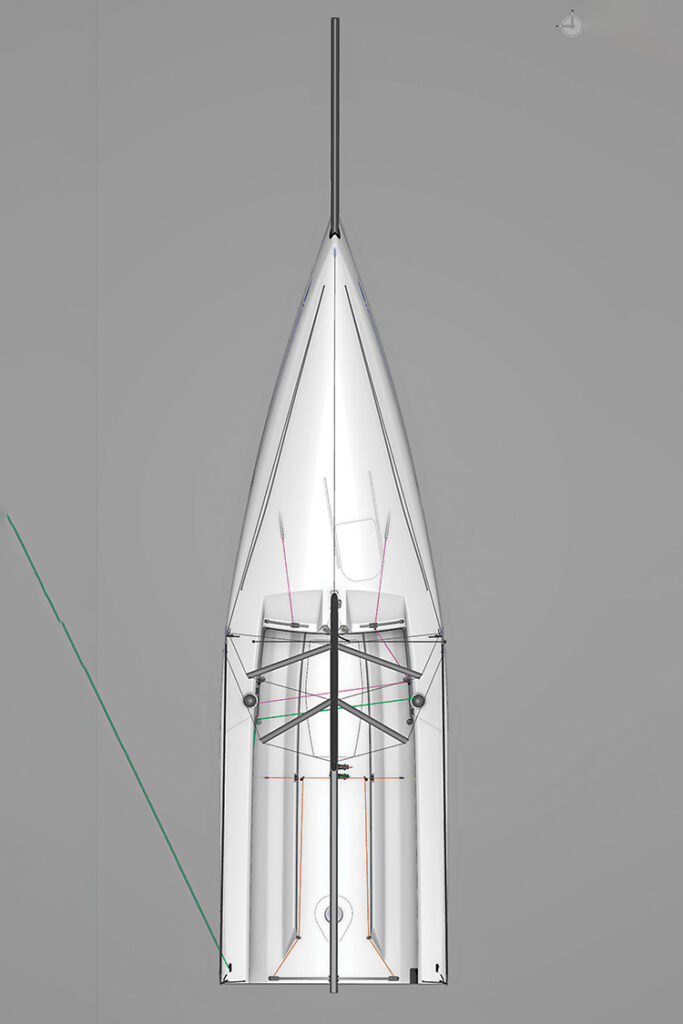 Nautor Swan now offers owners and crews an entree into the growing ClubSwan international regatta circuit.
Nautor Swan
Nautor Swan now offers owners and crews an entree into the growing ClubSwan international regatta circuit.
Nautor Swan
The solution is to have a permanently attached mast ram that can be operated while racing via a pump in the pit area. “It brings a lot of things together—not only the tension on the headstay, but also the tension on the rig,” Kouyoumdjian adds. “And when you tension the rig, you bend the mast.”
Therefore, powering up the rig comes with just two or three pumps and an inch of movement of the ram. “Everything on the rig is simple and has been done before many times successfully,” Kouyoumdjian says. “We added the mast up-and-down function. I imagine crews using it on medium-light days: When you get into a luff and you’d ease the runner, instead you’d drop the mast, or anticipating a puff, you’d pump it up. As soon as the wind gets to 10 to 12 knots, then you’d be maxed up, like you would be at maximum runner on a typical boat.”
The ClubSwan 28 will be a strict one-design class. Like the ClubSwan 36, it is being built in Cartagena, Spain, by Sinergia Racing Group. Tooling for the 28 is CNC milled to fine tolerances, and like most other boats in this size, it is a glass boat, built with vinylester resin, although naturally its mast, bowsprit and rudder are full carbon. The keel fin is stainless steel.
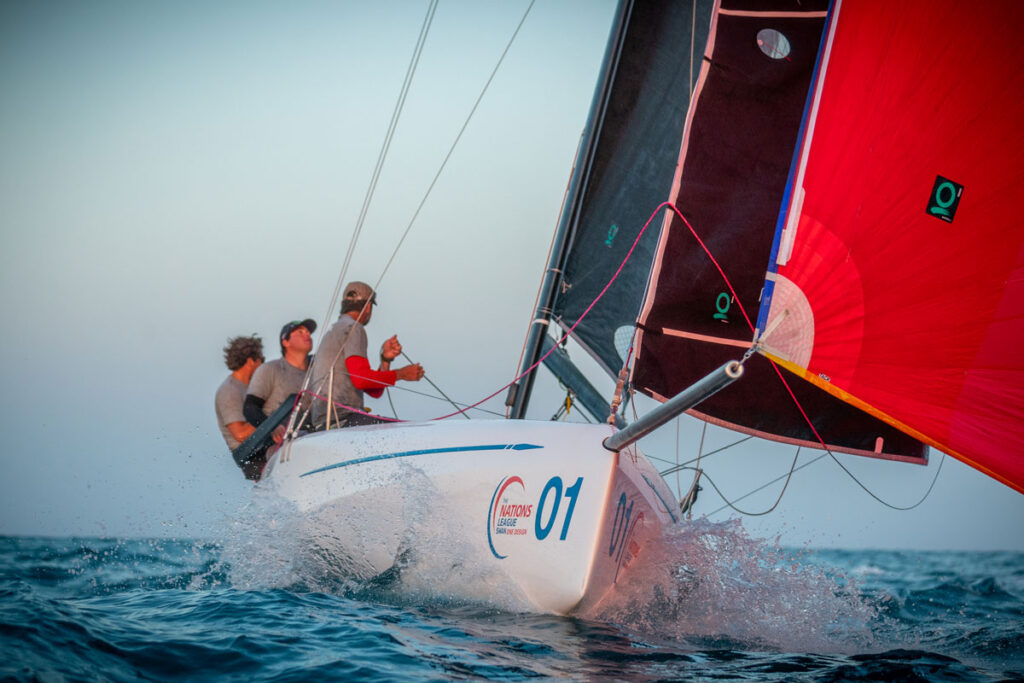 The ClubSwan 28 is designed to race with a crew of five with legs inboard. Reports from initial boat tests in Italy hint that attention to heel angle is important both upwind and downwind.
NautorsSwan
The ClubSwan 28 is designed to race with a crew of five with legs inboard. Reports from initial boat tests in Italy hint that attention to heel angle is important both upwind and downwind.
NautorsSwan
What appears to be a 1990s retro feature is the 28’s L-configuration keel, as featured on many vintage 1990 one-designs and early VO60s. Aside from positioning bulb weight aft, this lengthens the keel’s leading edge by 15 to 20 percent, increasing its efficiency and improving, for example, lift to windward. Kouyoumdjian is enthusiastic about this and says that he would readily recommend L-keels on other race boats, but warns that the shape of the bulb’s front must be correct. To enable easy trailering, the keel can be raised, and the rudder assembly lifts out within its own box. A full derig, from water to motorway, is expected to take around three hours.
Production for the ClubSwan 28 will be modest, initially at least, with the yard in Cartagena expected to roll out two per month, with the ready-to-sail price forecast to be around 200,000 euros. The aim is to have international fleets, with boats built by local yards. After Europe, Michetti says, its focus will be the United States, although as yet there is no time frame for this. At the time of this writing, six 28s had been sold, with the first boat due for launch in late May, with all six expected to compete at the Rolex Swan Cup in Porto Cervo in September.
The advantage of the 28 is that the owner is buying into the ClubSwan world, with its established circuit, Michetti says. “If you are building a new class, people need to trust you. You need to create momentum, you need to have sponsors and find locations and organize regattas,” which the ClubSwan management already has, with its comprehensive circuit, mixing established regattas and ClubSwan’s own in the Med, UK, Baltic and US. Aside from enticing new sailors and teams into the ClubSwan family, Michetti also imagines that some teams with larger race boats might acquire a 28 for crew training.
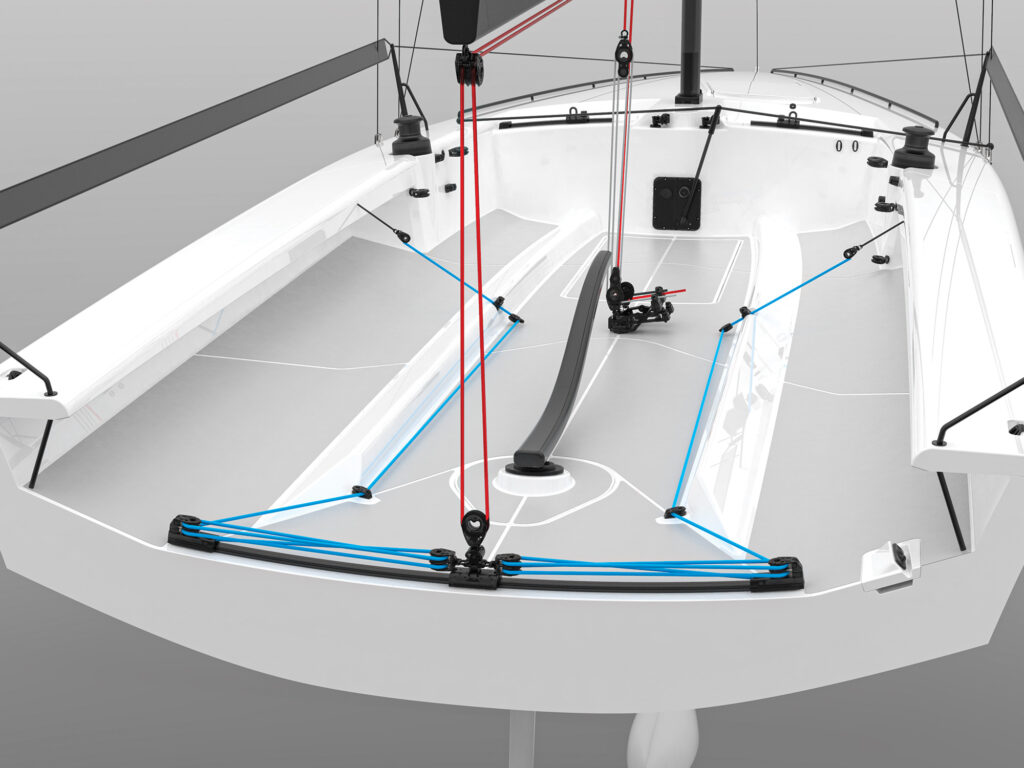 The first ClubSwan 28 emerged from its mold in Spain in late April, on schedule for European regattas later this summer.
Nautor Swan
The first ClubSwan 28 emerged from its mold in Spain in late April, on schedule for European regattas later this summer.
Nautor Swan
There is currently no class crew-weight limit, which risks enticing larger muscle-bound types on board, but Michetti explains: “We want to avoid this crazy ‘saunas before the regatta’ thing” (in other classes, crews typically duck just below maximum weight at weigh-in). ClubSwan 28 crews will comprise four or five with a World Sailing Group 1 (amateur) owner-driver and probably one mandatory female or youth crewmember.
For the 28 this year, there are a number of events, including a kick-off event from Nautor Swan’s base in Scarlino, Italy, in July, plus September’s Rolex Swan Cup and the Nations League 2024-ClubSwan 28 Invitational Sardinia Challenge, taking place in Villasimius, Sardinia, in early November. Given its trailerability, the likelihood is that the 28 will also race inland, for example, on Italy’s famous Lake Garda. Naturally, as numbers grow, there will also be the opportunity for the ClubSwan 28 to get its own start in the world’s top multiclass regattas.
The post Sporty and Simple is the ClubSwan 28 appeared first on Sailing World.
- Home
- About Us
- Write For Us / Submit Content
- Advertising And Affiliates
- Feeds And Syndication
- Contact Us
- Login
- Privacy
All Rights Reserved. Copyright , Central Coast Communications, Inc.